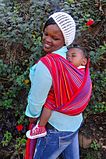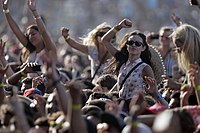User:Mcapdevila/Piggy back

The expression piggy back refers to the action of carrying a person on the back or shoulders of another person (could also be animals or inanimated things).[1] This may be done in order to transport someone from one place to another, or simply to be able to raise the position of the person on the shoulders, a very common case of carrying someone on the shoulders is usually to celebrate a triumph.[2]
Generally, adults use it to be able to carry other adults, children, or even animals like lambs, etc.. also in a similar way, inanimated things can be carried on the shoulders.
Two modes[edit]
A person can ride piggyback in two different ways:
On the first mode, the carried person leans his/her chest against the back of the porter and in addition it is a common habit to pass the arms around the neck and the legs around the waist of the porter to get a better support. This mode of transport requires less physical strength than the other mode, and is safer for both subjects. It is one of the modes[3] in the Finnish sport Eukonkanto.[4]
On the other mode, also known as "riding on the shoulders", the legs of the carried person are placed on either side of the porter's neck, sitting on top of the shoulders[5] with one leg hanging on either side of the porter's chest.[2] However, this action makes the center of gravity of the two subjects, a bit higher, which makes it more difficult to keep the balance, therefore, it is dangerous for corpulent people to be the one on top.[6]
Origin of the term[edit]

First option: It could be a corruption of pickaback, which is likely to be a folk etymology alteration of pick pack (1560s), which perhaps is from pick, a dialectal variant of the verb pitch.[7] because it's composed of the two words "piggy" derived from pig and "back".
Second option: Its etymological origin could be related to the position of baby pigs in the barn, laying half of them, on top of their "brother's back" and trying to reach a free nipple. In fact, since the beggining of times, when feeding them, the mother lays in horizontal position, and depending on the number of newborns, the baby pigs breastfeeding from the upper line of nipples, they are obliged to do it "piggybacking" on top of the back of "their brothers", those that are breastfeeding from the botom line of nipples (see picture) [8]
Piggybacking[edit]
The English expression, piggybacking, is used in multiple fields such as ophthalmology, electronics, electrical engineering, computer engineering, computer science, geology, transportation, telecommunications, etc..
Gallery[edit]



-
"Piggybacking" goods in a basket
-
"Piggybacking" a baby in a kikoi Toto wrap
-
"Piggybacking" Women in the middle of a crowd
-
"Piggybacking" a Koala
-
"Piggyback" game i Greece(500 B.C.)
-
Tsukioka Yoshitoshi "Higashi Nishiki: The Demon God Omatsu Shiro Saburo"
See also[edit]
- Autorack
- Bière–Apples–Morges Railway
- Car carrier trailer
- Car float
- Double-stack rail transport
- Ferry
- Fireman's carry
- Hupac
- Konkan Railway Corporation
- Loading gauge
- Modalohr
- Motorail
- Pichi Richi Railway
- Roadrailer
- Rolling highway
- Roll-on/roll-off
- Structure gauge
- Train ferry
- Two-foot-gauge railways in South Africa
References[edit]
- ^ Stevenson, A.; Waite, M. (2011). Concise Oxford English Dictionary: Luxury Edition. Concise Oxford English Dictionary. OUP Oxford. p. 1086. ISBN 978-0-19-960111-0. Retrieved 2023-02-17.
- ^ a b "Optimot. Linguistic inquiries". Llengua catalana (in Catalan). Retrieved 2023-02-15.
- ^ "Wife-carrying is a thing in Finland. This man and woman are world champions". South China Morning Post. 2018-07-08. Retrieved 2023-02-17.
- ^ English, Nick (2016-11-16). "Wife Carrying Is the Latest Strength Sport for Couples". BarBend. Retrieved 2023-02-17.
- ^ Jacobson, M. (2019). Moon Sauce. Page Publishing, Incorporated. p. 71. ISBN 978-1-64544-393-3. Retrieved 2023-02-17.
- ^ Pressey, R. (2011). How to Date a Werewolf. Magical Press. p. 149. ISBN 978-0-615-55749-6. Retrieved 2023-02-17.
- ^ Harper, Douglas. "piggyback". Online Etymology Dictionary. Retrieved 24 October 2012.
- ^ "piggy back". diccionari.cat (in Catalan). Retrieved 2023-02-15.
{{cite web}}: Text "diccionario.cat" ignored (help)
External links[edit]
- "Piggyback Paintings". Fine Art America. Retrieved 2023-02-17.






